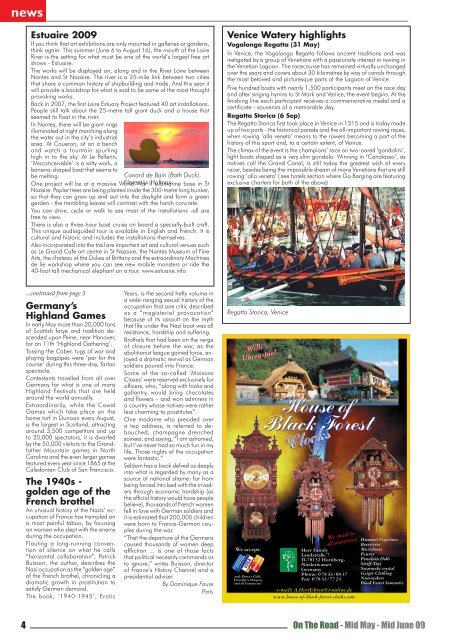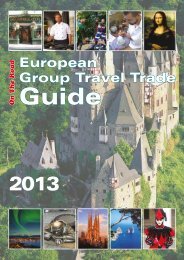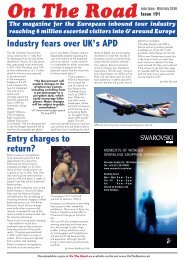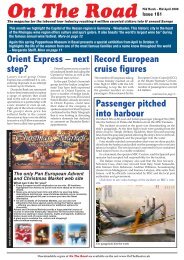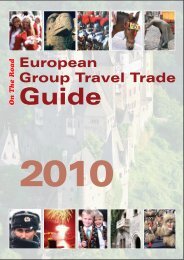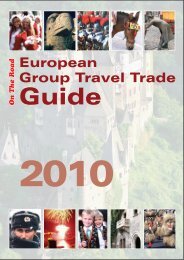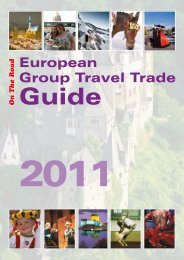Mid June 2009 - On The Road
Mid June 2009 - On The Road
Mid June 2009 - On The Road
- TAGS
- june
- road
- www.ontheroad.co.uk
Create successful ePaper yourself
Turn your PDF publications into a flip-book with our unique Google optimized e-Paper software.
news<br />
Estuaire <strong>2009</strong><br />
If you think that art exhibitions are only mounted in galleries or gardens,<br />
think again. This summer (<strong>June</strong> 6 to August 16), the mouth of the Loire<br />
River is the setting for what must be one of the world’s largest free art<br />
shows - Estuaire.<br />
<strong>The</strong> works will be displayed on, along and in the River Loire between<br />
Nantes and St Nazaire. <strong>The</strong> river is a 25-mile link between two cities<br />
that share a common history of shipbuilding and trade. And this year it<br />
will provide a backdrop for what is said to be some of the most thought<br />
provoking works.<br />
Back in 2007, the first Loire Estuary Project featured 40 art installations.<br />
People still talk about the 25-metre tall giant duck and a house that<br />
seemed to float in the river.<br />
In Nantes, there will be giant rings<br />
illuminated at night marching along<br />
the water out in the city’s industrial<br />
area. At Coueron, sit on a bench<br />
and watch a fountain spurting<br />
high in to the sky. At Le Pellerin,<br />
‘Misconceivable’ is a witty work, a<br />
banana-shaped boat that seems to<br />
be melting.<br />
Canard de Bain (Bath Duck).<br />
<strong>On</strong>e project will be at a massive World Florentijn War II Hofman<br />
submarine base in St<br />
Nazaire. Poplar trees are being planted inside the 300-metre long bunker,<br />
so that they can grow up and out into the daylight and form a green<br />
garden - the trembling leaves will contrast with the harsh concrete.<br />
You can drive, cycle or walk to see most of the installations -all are<br />
free to view.<br />
<strong>The</strong>re is also a three-hour boat cruise on board a specially-built craft.<br />
This unique audio guided tour is available in English and French. It is<br />
cultural and historic and includes the installations themselves.<br />
Also incorporated into the trail are important art and cultural venues such<br />
as Le Grand Cafe art centre in St Nazaire, the Nantes Museum of Fine<br />
Arts, the chateau of the Dukes of Brittany and the extraordinary Machines<br />
de lie workshop where you can see new mobile monsters or ride the<br />
40-foot tall mechanical elephant on a tour. www.estuaire.info<br />
...continued from page 3<br />
Germany’s<br />
Highland Games<br />
In early May more than 20,000 fans<br />
of Scottish farye and tradition descended<br />
upon Peine, near Hanover,<br />
for an 11th ‘Highland Gathering’.<br />
Tossing the Caber, tugs of war and<br />
playing bagpipes were ‘par for the<br />
course’ during this three- day, Tartan<br />
spectacle.<br />
Contestants travelled from all over<br />
Germany for what is one of many<br />
Highland Festivals that are held<br />
around the world annually.<br />
Extraordinarily, while the Cowal<br />
Games which take place on the<br />
home turf in Dunoon every August,<br />
is the largest in Scotland, attracting<br />
around 3,500 competi tors and up<br />
to 20,000 spectators, it is dwarfed<br />
by the 50,000 visitors to the Grandfather<br />
Mountain games in North<br />
Carolina and the even larger games<br />
featured every year since 1865 at the<br />
Caledonian Club of San Francisco.<br />
<strong>The</strong> 1940s -<br />
golden age of the<br />
French brothel<br />
An unusual history of the Nazis’ occupation<br />
of France has trampled on<br />
a most painful taboo, by focusing<br />
on women who slept with the enemy<br />
dur ing the occupation.<br />
Flouting a long-running convention<br />
of silence on what he calls<br />
“horizontal collabora tion”, Patrick<br />
Buisson, the author, describes the<br />
Nazi occu pation as the “golden age”<br />
of the French brothel, chronicling a<br />
dramatic growth in prostitu tion to<br />
satisfy German demand.<br />
<strong>The</strong> book, ‘1940-1945’, Erotic<br />
Years, is the second hefty vol ume in<br />
a wide-ranging sexual history of the<br />
occupation that one critic described<br />
as a “magisterial provocation”<br />
because of its assault on the myth<br />
that life under the Nazi boot was all<br />
resistance, hard ship and suffering.<br />
Brothels that had been on the verge<br />
of closure before the war, as the<br />
abolitionist league gained force, enjoyed<br />
a drama tic revival as German<br />
soldiers poured into France.<br />
Some of the so-called ‘Maisons<br />
Closes’ were reserved exclusively for<br />
officers, who, “along with looks and<br />
gallantry, would bring chocolates<br />
and flowers – and won admirers in<br />
a coun try whose natives were rather<br />
less charming to prostitutes”.<br />
<strong>On</strong>e madame who presided over<br />
a top address, is referred to debauched,<br />
champagne drenched<br />
soirees, and saying, “I am ashamed,<br />
but I’ve never had so much fun in my<br />
life. Those nights of the occupa tion<br />
were fantastic.”<br />
Seldom has a book delved as deeply<br />
into what is regarded by many as a<br />
source of national shame: far from<br />
being forced into bed with the invaders<br />
through economic hardship (as<br />
the official history would have people<br />
believe), thousands of French women<br />
fell in love with German soldiers and<br />
it is esti mated that 200,000 children<br />
were born to Franco-German couples<br />
during the war.<br />
“That the departure of the Germans<br />
caused thousands of women deep<br />
affliction ... is one of those facts<br />
that political necessity commands us<br />
to ignore,” writes Buisson, direc tor<br />
of France’s History Channel and a<br />
presidential adviser.<br />
By Dominique Faure<br />
Paris<br />
Venice Watery highlights<br />
Vogalonga Regatta (31 May)<br />
In Venice, the Vogalonga Regatta follows ancient traditions and was<br />
instigated by a group of Venetians with a passionate interest in rowing in<br />
the Venetian Lagoon. <strong>The</strong> racecourse has remained virtually unchanged<br />
over the years and covers about 30 kilometres by way of canals through<br />
the most beloved and picturesque parts of the Lagoon of Venice.<br />
Five hundred boats with nearly 1,500 participants meet on the race day<br />
and after singing hymns to St Mark and Venice, the event begins. At the<br />
finishing line each participant receives a commemorative medal and a<br />
certificate - souvenirs of a memorable day.<br />
Regatta Storica (6 Sep)<br />
<strong>The</strong> Regatta Storica first took place in Venice in 1315 and is today made<br />
up of two parts - the historical parade and the all-important rowing races,<br />
when rowing ‘alla veneta’ means to the rowers becoming a part of the<br />
history of this sport and, to a certain extent, of Venice.<br />
<strong>The</strong> climax of the event is the champions’ race on two-oared ‘gondolini’,<br />
light boats shaped as a very slim gondola. Winning in ‘Canalasso’, as<br />
natives call the Grand Canal, is still today the greatest wish of every<br />
racer, besides being the impossible dream of many Venetians that are still<br />
rowing ‘alla veneta’ ( see hotels section where Go Barging are featuring<br />
exclusive charters for both of the above)<br />
Regatta Storica, Venice<br />
4 <strong>On</strong> <strong>The</strong> <strong>Road</strong> - <strong>Mid</strong> May - <strong>Mid</strong> <strong>June</strong> 09


